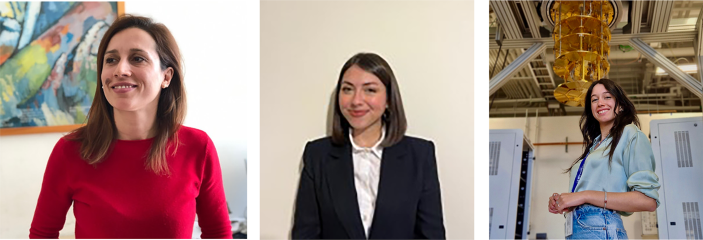
Credit: Angela Sara Cacciapuoti, Lorenza Criscuolo and Laura d’Avossa (Left to Right)
In 1996, Brian Carpenter, then chair of the Internet Engineering Task Force (IETF), stated that ‘the principle of constant change is perhaps the only principle of the Internet that should survive indefinitely’7. Decades later, this assertion continues to retain its validity.
The next paradigm shift will be the Quantum Internet, with the potential to unlock unparalleled communications and computing capabilities, by interconnecting quantum devices through a network infrastructure that leverages both quantum and classical communication links8,9. This breakthrough will transform critical sectors, such as defence, finance and healthcare. Among the most transformative applications emerging from the Quantum Internet are distributed quantum computing, unconditionally secure communications, advanced quantum sensing techniques, and blind quantum computing, ensuring privacy of outsourced quantum computations10.
However, the Quantum Internet operates under fundamentally different principles than the classical Internet. In fact, it is governed by the unique laws of quantum mechanics. Key quantum phenomena and principles, including the no-cloning theorem (which prevents perfect copying of unknown quantum states), quantum measurement postulate, quantum entanglement, and quantum decoherence, challenge the foundations of the classical Internet. Consequently, classical Internet protocols and techniques are inadequate or even inapplicable in the Quantum Internet, and bold new approaches are required for network design and operation.
In this context, as established in the foundational document ‘Quantum Internet architectural principles’11, entanglement, a uniquely quantum phenomenon where particles share correlated states regardless of the distance, emerges as the fundamental building block of quantum networking. Indeed, entanglement turns the Quantum Internet into a fundamentally new communication network, enabling functionalities with no counterpart in the classical Internet. A paradigmatic example is quantum teleportation12, which allows the transfer of information between distant nodes, without the physical transmission of the information carrier.
Consequently, a quantum-native protocol suite for the Quantum Internet must be specifically designed:
-
to fully incorporate entanglement unique properties and
-
to leverage its non-classical characteristics for network operation and functionalities13,14.
This requires moving beyond the classical internet networking paradigm, towards designing and developing fundamentally new approaches that properly account for the non-classical correlation exhibited by entangled states.
In the above perspective, the realization of a functional quantum-native Quantum Internet protocol suite13 necessitates substantial research efforts to address critical open challenges spanning multiple dimensions. Among the most pressing issues there are:
-
entanglement preservation across networks: entanglement remains a fragile resource, highly susceptible to environmental decoherence and rapid degradation over long distances;
-
integration with classical network infrastructures: assuring a seamless coexistence and interoperability with the classical Internet is imperative for the Quantum Internet development;
Overcoming these challenges demands a concerted multidisciplinary approach, integrating the expertise of physicists, computer scientists, communication and network engineers. Such a collaboration fosters the emergence of hybrid research communities beyond traditional disciplinary boundaries, by reshaping the very same structure of research. And this knowledge convergence from diverse domains not only accelerates technological progress, but it also epitomizes a broader social value, by representing a model for future scientific ecosystems rooted in openness, cooperation, and intellectual heterogeneity.
Linked with the above, we believe that equally critical is the commitment to build an inclusive scientific community, where diversity is not merely encouraged but recognized as an indispensable asset. Indeed, the persistent gender disparities in quantum science, which mirror broader trends in STEM fields, require proactive efforts to promote the participation of women. In fact, ensuring diverse representation enriches the field with a multiplicity of perspectives, ultimately strengthening the development of quantum technologies in a manner that reflects the full spectrum of global talent. Let’s reflect on the women’s legacy in the history of telecommunications, which laid the foundation for the sophisticated communication networks we rely on today. Choosing just one of these pioneering women is impossible! Let’s mention Kathleen Booth, whose work on the first assembly language and computer architecture powered breakthroughs in telco infrastructures, especially in data routing and switching. Meanwhile, Hedy Lamarr, the Hollywood star, co-invented frequency-hopping spread spectrum (FHSS), a foundational technology for modern telecommunications.
An additional significant challenge lies in raising public awareness regarding the transformative potential of the Quantum Internet. Nowadays, public engagement remains limited, with understanding largely confined to specialized industrial and academic circles. Strategic outreach initiatives and early education in quantum communication network domain can demystify the subject by fostering broader societal engagement. And we firmly feel that, by empowering future generations with foundational knowledge, we can prepare society for a technological revolution that promises to redefine not only communication networks, but also our very perception of reality.



